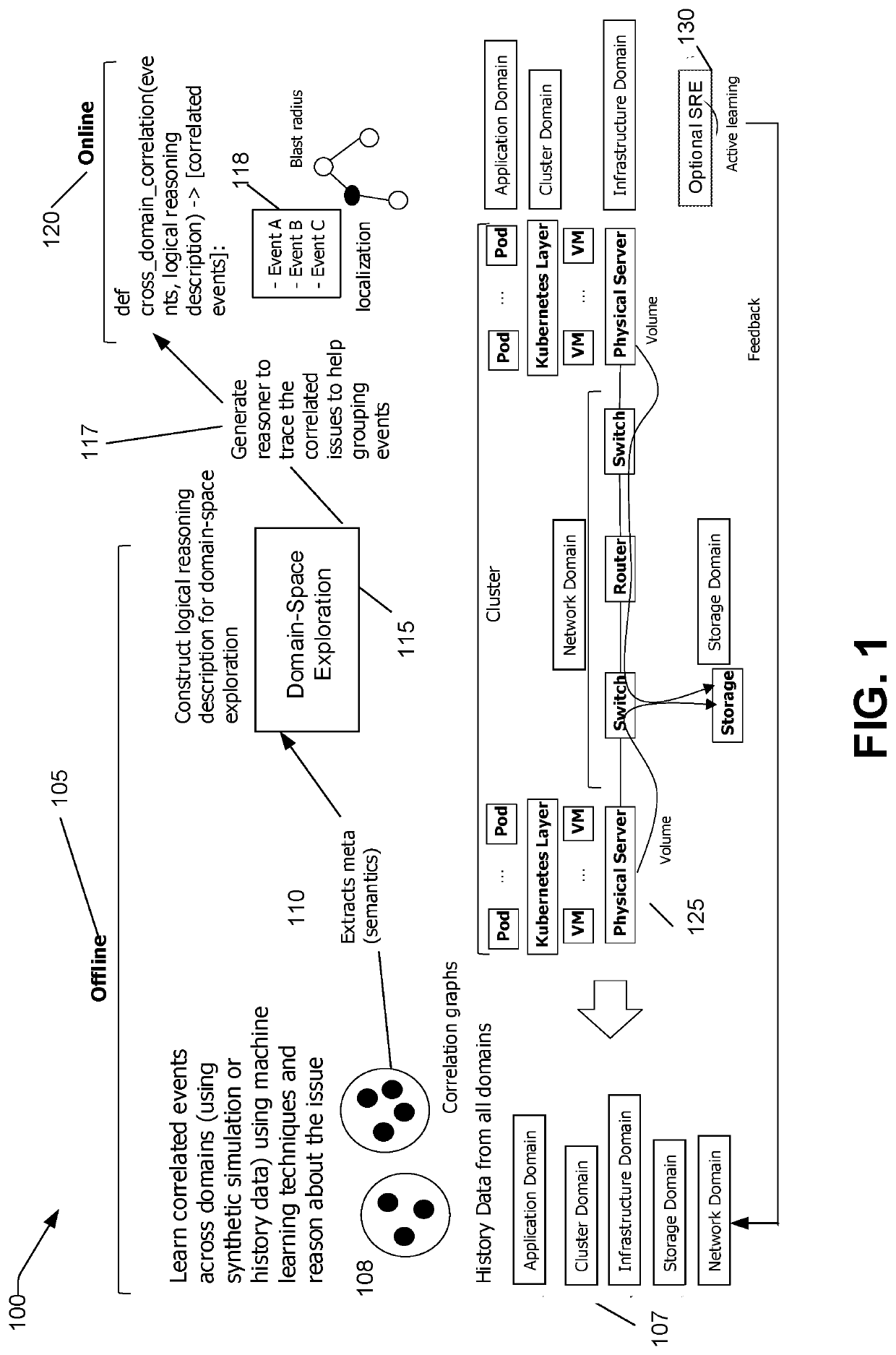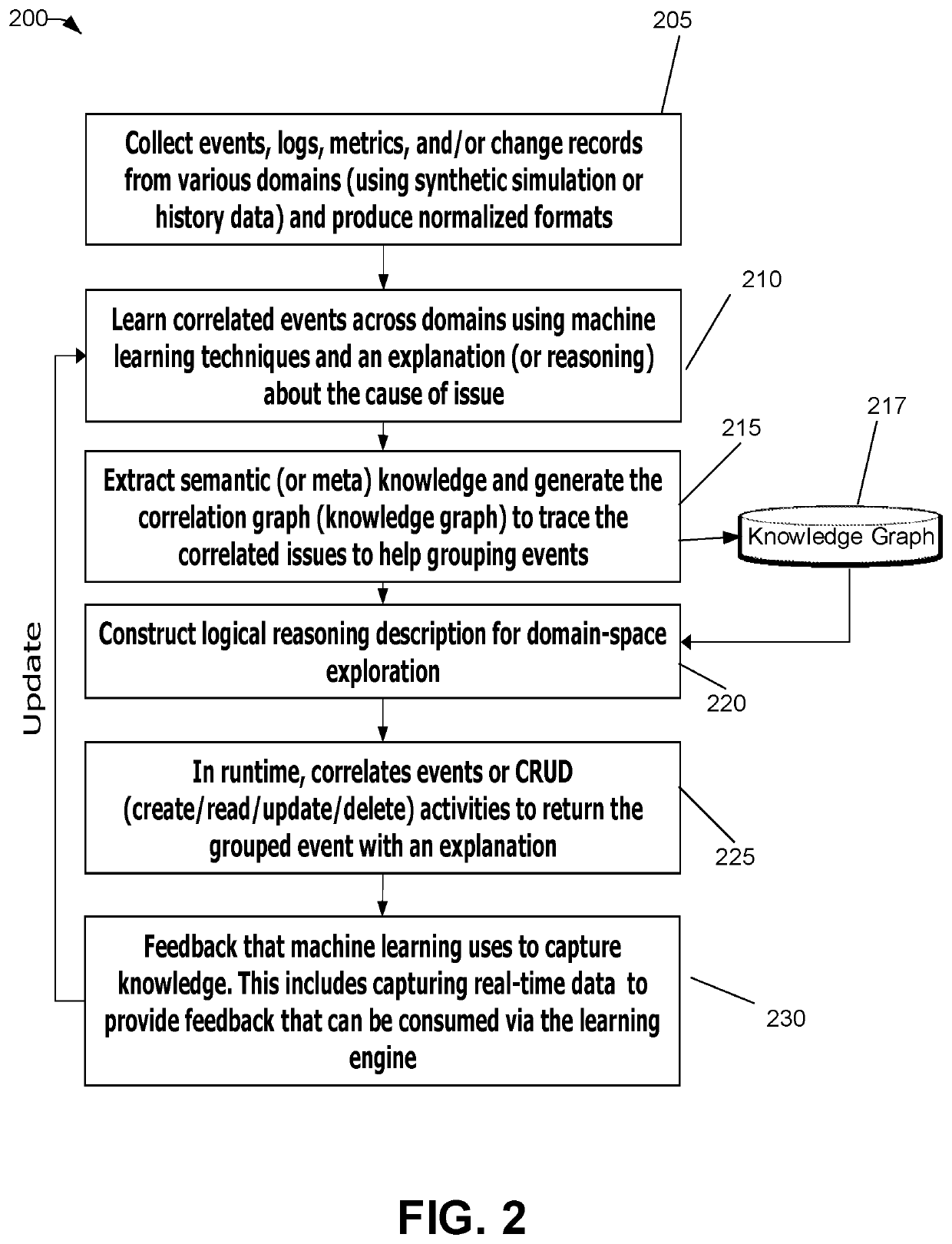Cross-Environment Event Correlation Using Domain-Space Exploration and Machine Learning Techniques
a domain-space exploration and event correlation technology, applied in the field of event correlation, can solve problems such as adversely affecting applications operating in another domain, operation of network devices in another domain that are not easily discoverable, and inability to diagnose and correct problems, so as to facilitate diagnosis and corrective action.
- Summary
- Abstract
- Description
- Claims
- Application Information
AI Technical Summary
Benefits of technology
Problems solved by technology
Method used
Image
Examples
example architecture
[0037]FIG. 1 is an overview of an architecture 100 of a system for cross-environment event correlation, consistent with an illustrative embodiment. As shown in the bracket offline 105, some of the operations may be performed with a system being offline, which can include data retrieval by collecting events, logs, metrics, or change records from various domains, using e.g., synthetic simulation or history data. A non-limiting example of domains 107 is shown, from which the history data may be obtained. Normalized formats may be generated from the retrieved data. There can be machine learning of correlated events 108 across domains and an explanation about a cause of the issue, for example, based on analyzing the issue.
[0038]With continued reference to FIG. 1, semantic knowledge or meta-knowledge 110 can be extracted from the retrieved data, and a correlation graph (e.g., a knowledge graph) is generated to trace the correlated issues to help the grouping of events. There is a domain-s...
example process
[0051]With the foregoing overview of the example architecture, it may be helpful now to consider a high-level discussion of an example process. To that end, in conjunction with FIGS. 1 and 2, FIG. 8 is a flowchart a computer-implemented method for cross-environment event correlation, consistent with an illustrative embodiment. Process 800 is illustrated as a collection of blocks, in a logical flowchart, which represents a sequence of operations that can be implemented in hardware, software, or a combination thereof. In the context of software, the blocks represent computer-executable instructions that, when executed by one or more processors, perform the recited operations. Generally, computer-executable instructions may include routines, programs, objects, components, data structures, and the like that perform functions or implement abstract data types. In each process, the order in which the operations are described is not intended to be construed as a limitation, and any number o...
example cloud
Platform
[0063]As discussed above, functions related to cross-environment event correlation according to the present disclosure may include a cloud. It is to be understood that although this disclosure includes a detailed description of cloud computing as discussed herein below, implementation of the teachings recited herein is not limited to a cloud computing environment. Rather, embodiments of the present disclosure are capable of being implemented in conjunction with any other type of computing environment now known or later developed.
[0064]Cloud computing is a model of service delivery for enabling convenient, on-demand network access to a shared pool of configurable computing resources (e.g., networks, network bandwidth, servers, processing, memory, storage, applications, virtual machines, and services) that can be rapidly provisioned and released with minimal management effort or interaction with a provider of the service. This cloud model may include at least five characterist...
PUM
 Login to View More
Login to View More Abstract
Description
Claims
Application Information
 Login to View More
Login to View More - R&D
- Intellectual Property
- Life Sciences
- Materials
- Tech Scout
- Unparalleled Data Quality
- Higher Quality Content
- 60% Fewer Hallucinations
Browse by: Latest US Patents, China's latest patents, Technical Efficacy Thesaurus, Application Domain, Technology Topic, Popular Technical Reports.
© 2025 PatSnap. All rights reserved.Legal|Privacy policy|Modern Slavery Act Transparency Statement|Sitemap|About US| Contact US: help@patsnap.com



